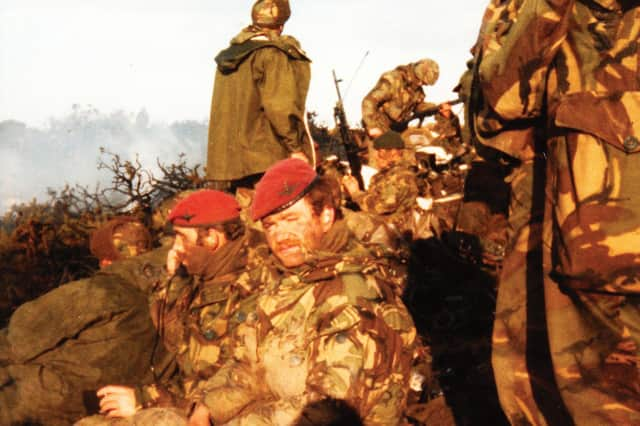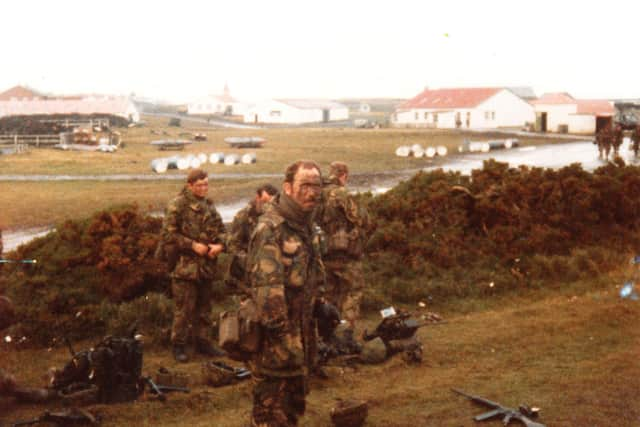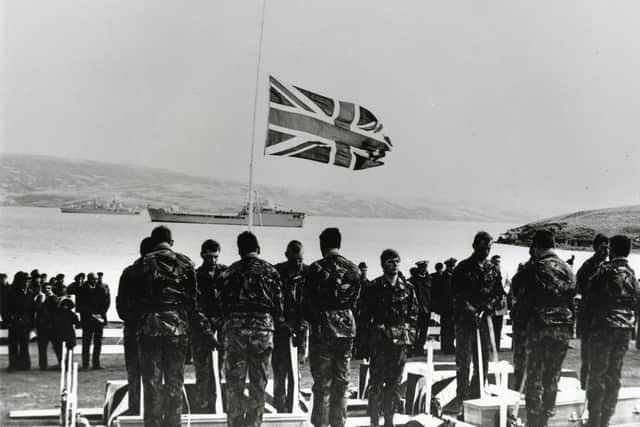Falklands War 40th anniversary: Paras under fire in first crucial Battle of Goose Green


Second in command of C Company Lieutenant Peter Kennedy, says the first major battle the British Army had fought for a generation, was something like out of World War One.
Now a retired Major, Mr Kennedy had just given the order to fix bayonets: “Initially when we went over the top it was so comical, I started whistling the theme tune from Dad’s Army.
Advertisement
Hide AdAdvertisement
Hide Ad“Some of the soldiers joined in. We soon stopped whistling. It was absolutely terrifying.”


The battle of Goose Green was the first and hardest fought battle of the Falklands War, from May 27 to May 29 1982. British troops had landed at San Carlos Bay five days earlier and politicians back in the UK were desperate for some early wins to boost morale.
The former paratrooper will be reliving the battle - with the help of sound effects, film clips, and some of the weapons used- in a fundraising talk at the Army Foundation College at Harrogate on May 27 the 40th anniversary.
The odds were stacked against 2nd Battalion, Parachute Regiment (2 Para),as they were heavily outnumbered and lacked proper fire support.
Advertisement
Hide AdAdvertisement
Hide AdC Company was in reserve, but towards the end they were called in to capture the last hill and airstrip overlooking Goose Green.


“We were told it was a mopping up operation - we’d captured or killed most of the enemy and we thought there’d be just a few rounds fired at us.” However all hell let loose, with fire from medium and heavy Browning machine guns. Then mortar rounds started falling and heavier artillery- the most daunting coming from the eight anti-aircraft guns that surrounded the airstrip.
They dived for cover - but there wasn’t any, the ground as flat “as a billiard table”.
Mr Kennedy, pressing his face to the earth, envied a bug crawling safely on a blade of grass.
Advertisement
Hide AdAdvertisement
Hide Ad“You freeze and you scream out for your mother, but no one comes - you have to get a grip and start firing back,” said Mr Kennedy who had done two tours in Northern Ireland.
“I managed to get hold of the mortar fire controllers and bought down mortar and artillery fire onto the anti-aircraft guns and took out four of them.”
They could see the puffs of smoke showing where the enemy was firing from but were told their artillery couldn’t be used as they were too close to the village “so we had to get the guns ourselves”.
2 Para had lost 20 men in Northern Ireland, 16 in the Warrenpoint bombing of 1979. But he says the Falklands - where they lost 18 men killed in just six or seven weeks - was much more intense and dangerous.
Advertisement
Hide AdAdvertisement
Hide Ad“You are living absolutely on the edge. The excitement kicks in, and there’s a serotonin and endorphin rush which makes you run forward. You can go from coward to hero in seconds.”
After the company commander was wounded, Mr Kennedy took command, capturing the last hill and the enemy flag on its summit.
While the merits of the battle are still hotly debated, he believes it was the right thing to do, and says every clash after that was easier as the Argentinians “knew what was coming” as well as reminding their own troops what it was like to be in a “proper” war.
He recalls commanding officer Lieutenant Colonel ‘H’ Jones - who was awarded the posthumous Victoria Cross - reacting to the order to attack with schoolboy delight and says friends who weren’t there missed a “great adventure”.
Advertisement
Hide AdAdvertisement
Hide AdHe accepts it is all a matter of perspective. 2 Para lost 17 killed and about 35 wounded, while the Argentinians lost about 55 killed and 86 wounded.“The people who came out physically and mentally OK look back and think it was a high point, people who were badly injured may have a different perspective and then there were those who were killed,” he says.
Peter Kennedy’s talk is from 7pm to 9.30pm on May 27. Proceeds will be shared between Support Our Paras, Sue Ryder Hospice, ABF The Soldiers’ Charity, and The Royal British Legion.
There will be a small military display of weapons and equipment outside the lecture theatre. Cash bar for food, drinks and raffle. Book tickets (£15) on www.eventbrite.co.uk/e/the-falklands-conflict-40th-anniversary-tickets-292471659607